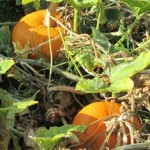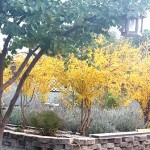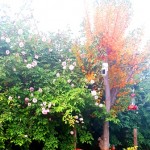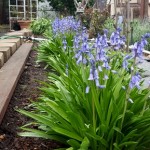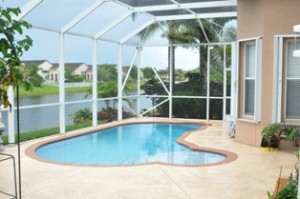Celebrate the Ever-Evolving Garden
There’s nothing to rejuvenate a weary soul like time spent in a garden. Death of one season’s plants yields to new shoots the next. Because I appreciate the ever-evolving nature of a garden, I choose plants, bulbs, bushes, and trees that offer visual interest in each season. Thoughtful planting generates an ever-evolving landscape of color, texture, and visual interest.
The autumn garden has almost completely morphed into a winter landscape now. Pumpkin and tomato vines have been pulled out and perennials in the bee garden have gone to seed or been cut back. Winter offers little color in the garden except for the cape honeysuckle, white geranium, lavender florets, and early flowering bulbs.
Deciduous trees have mostly lost their leaves, however, the eucalyptus and the pepper trees here on the farmette remain leafy and green. The rains have come and a dusting of snow on nearby mountain peaks is in the forecast ahead. Foliage and blooms are mostly gone. It’s that time of year to cover frost-sensitive plants.
The pomegranates that were ablaze in golden color a few weeks ago have dropped all leaves. What remains is the lovely arching pattern of branches since I’ve trained them from bushes into trees.
The showy pink flowers over summer of the crape myrtle are a memory. Gone now, too, are the red-gold leaves of fall. What remains is an interesting gray-green bark.
The seeds from the giant yellow-orange coreopsis that stood eight feet tall and towered over zinnias, Borage, and rows of lavender have long ago been harvested. Also, my patch of lavender is flourishing. The plants have pushed out long stalks of purple florets.
Dark green shoots of bulbs are pushing up out of the earth where I interplanted them with chrysanthemums. I cut back the mums and they will reappear in the spring to flower again. This is the time of year that shoots of bulbs and rhizomes are birthing daffodils, anemones, tulips, hyacinths, and, to come later, lilies and irises of many colors.
In raised beds, shoots of fall-planted onions and garlic are now pushing up. The bees are drawn to the sweet scent of narcissus bulbs that have naturalized after being planted years ago. The Meyer lemon now has lots of yellow thin-skinned fruit and also a few early blooms.
On the dark days and nights of winter, white blooming plants stand in stark contrast to gray wooden fences and leafless trees. Honor roses, Iceberg roses, and climbing Sally Holmes roses have showy white blooms and may even have some this time of year unless they’ve been cut back. Winter-blooming gardenias and white geraniums have a quiet impact when grouped together in hedges, beds, or containers.
With so many bulbs and plants available this time of year, putting interest into your winter garden is easy and contributes to an ever-evolving landscape.
Consider plants with gray-green or otherwise pretty foliage and colorful berries. Also plant trees with interesting bark colors, textures, patterns, or scaffolding shapes. When you think of plants for each season of the year, you’ll have a garden to nurture you throughout the year.
____________________________________________________
If you enjoy reading about gardening, the keeping of chickens and bees, and other small farm topics AND you’d like related gift-giving, consider my Henny Penny Farmette series of cozy mysteries or any of my health, wellness, and spirituality books. All are available online and in traditional bookstores everywhere.
AVAILABLE NOW. Tap control click in the following link: https://www.amazon.com/How-Live-Intention-Meaning-Purpose-ebook/dp/B07GNVFWSF/ref=sr_1_1?ie=UTF8&qid=1544206797&sr=8-1&keywords=Meera+Lester%2BHow+to+Live+with+Intention
To Purchase, tap control click on the link:
Plants for Sun Rooms, Solariums, and Conservatories
My husband and I grew exotic flowers in and around our Miami, Florida home. We had a sun room that sheltered a swimming pool in which I swam laps in every day. The space seemed near perfect for growing orchids in cycles of perpetual bloom. They loved loved the heat, light, and moisture provided by the pool and a fountain we installed. We also had an angel trumpet tree (Datura arborea) in the front of the house, adding drama and a luscious scent to the entry area.
But with the freezing winter temperatures on our Northern California farmette, such plants would not survive unless grown in a conservatory type of room with lots of warmth and light.
Since buying the farmette, my hubby and I have toyed with the idea of building such a space, also known as sun room, greenhouse room, tea room, and solarium.
A major consideration besides money and materials would be the direction the room would face. For our farmhouse, the direction (also known as “aspect”) could be north where the patio is already located or if positioned at the front of the house (where we had planned to create a wraparound front porch), the sun room or conservatory’s aspect would face south.
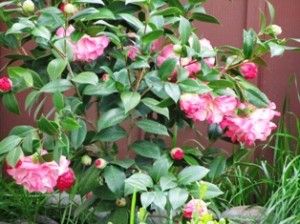
This Camellia japonica produces attractive blooms in early to mid spring and would do well in a cooler sun room
A north-facing aspect permits plenty of light but less heat. In a cooler conservatory or sun room, we’d use more foliage plants such as camellia, begonia, geranium, anthurium, Australian bottle brush, fuchsia, ficus, gardenia, campanula, hypoestes , and various types of ivy and palm. We could also grow Cymbidium orchids that like dappled shade during summer but bloom in the dead of winter.
A south or west direction ensures intense light and heat and would allow us to grow more flowering plants (especially ones found in the subtropics and tropics), including exotic orchids.
My husband grew up on a Caribbean island and loves orchids. The cymbidium orchids do well enough already outside. We put them in protected areas on frosty nights. But many of the exotic orchids require light, heat, and, in some cases, additional moisture.
We know Phalaenopsis, odontoglossum, and slipper orchids would thrive in a conservatory room that faces south or west as would many other plants such as hibiscus, jasmine, nephrolepsis, passion flower, plumeria, and African violet, to name a few. Also, many hybrid rhododendrons that profusely flower for long periods can be grown in containers in a warm environment.
I’m really an outside garden girl, but a conservatory room with a lot of interesting architectural detail and gorgeous blooming plants could make me want to spend more time indoors. It doesn’t matter to me whether it faces north or south. But dare I bring up the idea of adding a pool?
 Facebook
Facebook Goodreads
Goodreads LinkedIn
LinkedIn Meera Lester
Meera Lester Twitter
Twitter





